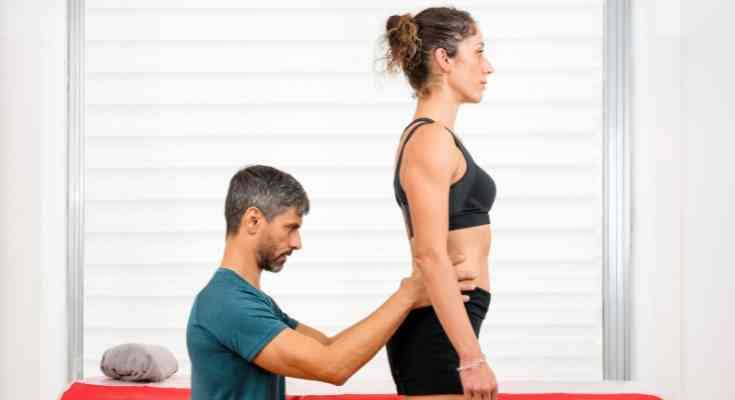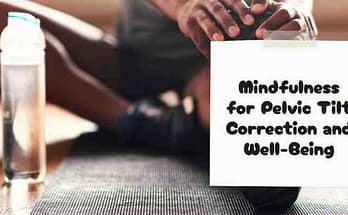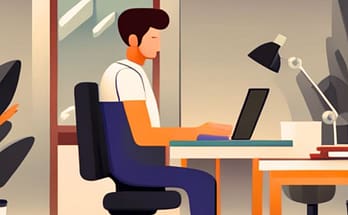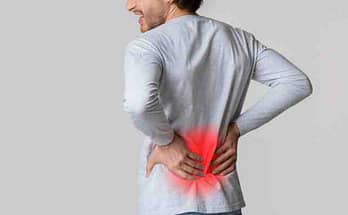Do you struggle with lower back pain or have trouble maintaining good posture? If so, you may be experiencing anterior pelvic tilt.
In this comprehensive anatomy guide, we will explore anterior pelvic tilt, its causes, symptoms, diagnosis, and treatment options. Whether you’re an athlete, pregnant, or simply looking to improve your posture and overall health, understanding anterior pelvic tilt is key to achieving your goals.
Overview of Anterior Pelvic Tilt
Anterior pelvic tilt occurs when the front of the pelvis drops down and the back of the pelvis rises up, causing an excessive curve in the lower back. This condition can cause various problems such as lower back pain, hip pain, and even knee and foot pain. It’s important to understand the anatomy behind anterior pelvic tilt in order to effectively address and prevent it.
The pelvis is made up of three bones: the ilium, ischium, and pubis. These bones are connected by strong ligaments and joints, and they form a bowl-shaped structure that supports the weight of the upper body.
When the pelvis is tilted anteriorly, the hip bones rotate forward, which causes the lumbar spine to arch excessively. This puts pressure on the lower back muscles, causing them to become tight and strained.
Understanding the anatomy of the pelvis is crucial in understanding how to correct anterior pelvic tilt and prevent related pain and discomfort.
Anatomy of the Pelvis
The pelvis is a bony structure that connects the spine to the legs, and it plays a crucial role in supporting the body’s weight. Understanding the anatomy of the pelvis is important in understanding anterior pelvic tilt.
Here are a few things you should know about the pelvis:
- The pelvis is made up of three bones: the ilium, ischium, and pubis.
- The ilium is the largest of the three bones and forms the upper part of the pelvis.
- The ischium forms the lower and back part of the pelvis, and it supports the weight of the body when sitting.
- The pubis is the front part of the pelvis and it connects the two hip bones together.
It’s important to note that the pelvis is not a static structure and can move in different ways depending on the muscles that attach to it. Understanding how these muscles work and interact with the pelvis is key to understanding how anterior pelvic tilt occurs.
Causes of Anterior Pelvic Tilt
Knowing what causes APT can be eye-opening and may even make you rethink some of your daily habits. The most common cause of anterior pelvic tilt is a sedentary lifestyle. If you spend most of your day sitting, your hip flexor muscles will become tight, pulling your pelvis forward and downward. This can lead to an exaggerated curve in your lower back and a protruding belly.
Another cause of anterior pelvic tilt is poor posture. When you stand with your shoulders slouched and your hips pushed forward, you are putting extra stress on your lower back, which can lead to APT. Additionally, weak core and glute muscles can contribute to APT as they are important for stabilizing the pelvis. To help you better understand the causes of APT, take a look at the table below:
| Cause | Effect |
|---|---|
| Sedentary Lifestyle | Tight Hip Flexors |
| Poor Posture | Exaggerated Lower Back Curve |
| Weak Core and Glute Muscles | Pelvic Instability |
By understanding the causes of APT, you can take steps to correct it. Incorporating regular exercise and stretching into your routine can help alleviate tight hip flexors and strengthen weak muscles. Additionally, being mindful of your posture throughout the day can help prevent APT from occurring in the first place.
Symptoms of Anterior Pelvic Tilt
If you’ve got an anterior pelvic tilt, you may experience lower back pain, hip pain, poor posture, and limited mobility. Your lower back may feel stiff or achy, and you may have trouble standing or sitting for long periods. Your hips may also feel tight or uncomfortable, and you may have difficulty moving them freely.
Poor posture and limited mobility are also common symptoms of anterior pelvic tilt, as your body compensates for the imbalance in your pelvis.
Lower Back Pain
Lower back pain can be a common symptom of anterior pelvic tilt, but it can also be caused by a variety of other factors. If you’re experiencing lower back pain, it’s important to identify the root cause in order to address it properly.
Here are some possible causes of lower back pain and how they relate to anterior pelvic tilt:
| Possible Cause | Relationship to Anterior Pelvic Tilt |
|---|---|
| Tight hip flexors | Pull the pelvis forward, creating an excessive curve in the lower back and contributing to pain |
| Weak glutes | Inability to counteract the pull of hip flexors, leading to strain on the lower back |
| Poor posture | Extra stress on the lower back due to slouched position or hips pushed forward |
By addressing these underlying causes, you can not only alleviate your lower back pain but also improve your overall posture and reduce the likelihood of developing anterior pelvic tilt in the future.
Hip Pain
Experiencing hip pain can be a frustrating and uncomfortable issue for many people. It can make simple tasks like sitting, standing, or walking unbearable.
In most cases, hip pain is caused by an anterior pelvic tilt, which is a condition where the pelvis tilts forward, causing the hip joints to become misaligned.
To alleviate hip pain caused by an anterior pelvic tilt, you need to work on correcting the tilt. One way to do this is by strengthening your hip muscles through exercises like squats, lunges, and leg raises. Additionally, stretching your hip flexors and lower back can also help relieve pain.
It’s important to consult with a healthcare professional or physical therapist to get a proper diagnosis and personalized treatment plan for your hip pain.
Poor Posture
Having poor posture can lead to aches and pains, but with some simple adjustments, you can improve your alignment and feel better. When your posture is not optimal, it can cause strain on your muscles and joints, leading to discomfort and even injury over time. Common symptoms of poor posture include back pain, headaches, neck pain, and fatigue.
To improve your posture, start by becoming more aware of your body positioning throughout the day. Use the table below as a guide to check your posture and make adjustments as needed. Additionally, try incorporating exercises that strengthen your core and back muscles, as well as stretches that target tight areas such as your chest and hip flexors. With consistent effort, you can improve your posture and alleviate pain and discomfort caused by poor alignment.
| Body Part | Correct Alignment | Incorrect Alignment |
|---|---|---|
| Head | Aligned with spine, chin parallel to floor | Jutting forward, chin tilted up or down |
| Shoulders | Relaxed and pulled back | Hunched forward or shrugged up |
| Chest | Expanded and lifted | Collapsed and sunken |
| Spine | Straight with natural curves | Slouched or hyperextended |
| Hips | Level and aligned with shoulders | Tilted forward or backward |
| Feet | Planted firmly on the ground with weight evenly distributed | Twisted or turned inward/outward |
Limited Mobility
Improving mobility is essential for maintaining a healthy and active lifestyle. Limited mobility can be caused by a variety of factors, including poor posture, muscle imbalances, and injuries. When you have limited mobility, you may find it difficult to perform everyday activities, such as reaching for objects on high shelves or bending down to tie your shoes.
To improve your mobility, you can try the following techniques:
- Stretching: Regular stretching can help increase your flexibility and range of motion.
- Foam rolling: Foam rolling can help release tension in your muscles and improve your mobility.
- Strength training: Strength training can help improve your muscle strength and stability, which can, in turn, improve your mobility.
- Physical therapy: If you have limited mobility due to an injury or medical condition, physical therapy can help you regain your mobility.
By incorporating these techniques into your daily routine, you can improve your mobility and maintain a healthy and active lifestyle.
Remember, it’s important to consult with a healthcare professional before starting any new exercise or mobility routine.
Diagnosis and Assessment
Assessing anterior pelvic tilt can be challenging, as it requires a thorough understanding of pelvic anatomy and proper assessment techniques. To diagnose and assess anterior pelvic tilt, a physical examination and evaluation of the patient’s medical history are necessary. The examination should include postural analysis, range of motion testing, and muscle strength testing.
Postural analysis involves observing the patient’s standing posture from the front, back, and side. The examiner should look for any asymmetries in the pelvis, such as a higher hip or a rotated pelvis.
Range of motion testing includes assessing the patient’s ability to move their hips in flexion, extension, abduction, and adduction.
Muscle strength testing involves evaluating the strength of the hip flexors, extensors, abductors, and adductors. The results of these tests can help determine the severity of anterior pelvic tilt and guide treatment options.
| Assessment | Description |
|---|---|
| Postural Analysis | Observe patient’s standing posture from the front, back, and side |
| Range of Motion Testing | Assess patient’s ability to move hips in flexion, extension, abduction, and adduction |
| Muscle Strength Testing | Evaluate strength of hip flexors, extensors, abductors, and adductors |
Proper diagnosis and assessment of anterior pelvic tilt is crucial in determining the best course of treatment. By understanding the anatomy of the pelvis and using appropriate assessment techniques, healthcare professionals can accurately diagnose anterior pelvic tilt and develop effective treatment plans.
Treatment Options
There are various ways to treat anterior pelvic tilt, including exercises, manual therapy, and postural correction techniques. Exercises can help strengthen and stretch the muscles that contribute to anterior pelvic tilt. These may include hip flexor stretches, glute bridges, and planks.
Manual therapy, such as massage and chiropractic adjustments, can also be effective in treating anterior pelvic tilt. These techniques can help release tension in the muscles and joints that may be contributing to the tilt.
Postural correction techniques, such as using a lumbar roll or correcting your standing and sitting posture, can help retrain your body to maintain a neutral pelvis. By incorporating these treatment options into your routine, you can help alleviate the symptoms of anterior pelvic tilt and improve your overall posture and health.
Prevention and Management
To prevent and manage anterior pelvic tilt, you’ll want to make small adjustments to your daily routine and posture habits. Here are a few things you can do:
- Stand up straight and engage your core muscles. This will help keep your pelvis in a neutral position.
- Stretch regularly to prevent tightness in your hip flexors and lower back muscles. This can be especially helpful if you sit for long periods of time.
- Incorporate exercises that strengthen your glutes and hamstrings, such as squats and deadlifts. Stronger muscles in your lower body can help support your pelvis and prevent it from tilting forward.
By making these small changes, you can prevent and manage anterior pelvic tilt, reducing your risk of pain and discomfort in the lower back and hips.
Remember to be consistent with your efforts and seek the advice of a healthcare professional if you have any concerns.
Common Myths and Misconceptions
Don’t fall for common myths and misconceptions about how to prevent and manage anterior pelvic tilt – you may be doing more harm than good.
One of the most popular myths is that doing a lot of sit-ups and crunches will help fix the problem. However, this is not true. These exercises can actually worsen the anterior pelvic tilt by tightening the hip flexors and pulling the pelvis forward, exacerbating the tilt.
Another misconception is that stretching alone is enough to fix anterior pelvic tilt. While stretching can be helpful in alleviating tightness in the hip flexors and other muscles, it is not a standalone solution. Strengthening exercises for the glutes, hamstrings, and abdominals are also important in correcting the tilt.
Additionally, it’s important to address any underlying issues, such as posture or gait abnormalities, that may be contributing to the problem. By understanding the truth behind these myths, you can better prevent and manage anterior pelvic tilt.
Addressing Anterior Pelvic Tilt in Fitness
Now that you’re aware of the myths and misconceptions surrounding anterior pelvic tilt, it’s time to focus on addressing this issue in your fitness routine. Whether you’re a seasoned gym-goer or a beginner, understanding how to correct your pelvic alignment can greatly improve your overall physical health.
One way to address anterior pelvic tilt is through strengthening exercises that target the muscles in your hips, lower back, and core. This includes exercises such as squats, lunges, deadlifts, and planks. By incorporating these movements into your workouts, you’ll be able to strengthen the muscles that support your pelvis and improve your posture.
Additionally, stretching exercises can also help to release tension in tight muscles, such as the hip flexors and lower back, which can contribute to anterior pelvic tilt. By committing to a well-rounded fitness routine that includes both strength training and stretching, you’ll be on your way to correcting your pelvic alignment and improving your overall physical well-being.
Addressing Anterior Pelvic Tilt in the Workplace
If you spend a significant amount of time sitting at a desk, you may be exacerbating your anterior pelvic tilt without even realizing it. Sitting for long periods of time can cause your hip flexors to become shortened and tight, pulling your pelvis forward and increasing the curve in your lower back. This can lead to lower back pain, tightness in the hips and hamstrings, and even poor posture.
To address anterior pelvic tilt in the workplace, try incorporating the following tips into your daily routine:
- Take frequent breaks to stand up and stretch your hip flexors
- Use a standing desk or adjustable desk converter to alternate between sitting and standing
- Engage your core muscles throughout the day to help maintain proper posture
- Consider using a stability ball as a chair to engage your core and improve your balance.
By making small changes to your daily routine, you can help alleviate the symptoms of anterior pelvic tilt and improve your overall health and well-being.
Addressing Anterior Pelvic Tilt in Pregnancy
During your pregnancy, you may be experiencing anterior pelvic tilt which can cause discomfort and pain in your lower back and hips. This is because as your baby grows, your center of gravity shifts forward, causing your pelvis to tilt anteriorly. This can lead to tight hip flexors, weak glutes, and an exaggerated curve in your lower back.
To address anterior pelvic tilt during pregnancy, it’s important to focus on stretches and exercises that target the hip flexors and glutes, while also maintaining good posture. Gentle yoga poses, such as pigeon pose and butterfly pose, can help stretch the hip flexors and alleviate discomfort.
Additionally, exercises such as squats, lunges, and bridges can help strengthen the glutes and reduce the tilt in your pelvis. Remember to always listen to your body and consult with your healthcare provider before starting any new exercise regimen.
Addressing Anterior Pelvic Tilt in Aging
As you age, your body undergoes significant changes that can lead to discomfort and pain in your lower back and hips. One of the most common causes of this discomfort is anterior pelvic tilt, which occurs when the pelvis tilts forward, causing the lower back to arch excessively. This can put pressure on the lower back and hips, leading to pain and stiffness. However, there are exercises and stretches that you can do to address this issue and alleviate your discomfort.
One effective way to address anterior pelvic tilt is through targeted exercises that strengthen the muscles of the lower back, hips, and core. These exercises can help you improve your posture and alignment, reducing the strain on your lower back and hips. Additionally, stretching can help you release tension in the muscles that contribute to anterior pelvic tilt, further reducing your discomfort. By incorporating these exercises and stretches into your daily routine, you can improve your overall mobility and quality of life.
| Exercise | Description | Benefits |
|---|---|---|
| Hip flexor stretch | Kneel on one knee with your other foot in front of you, and lean forward until you feel a stretch in your hip flexors. | Relieves tension in hip flexors, which contribute to anterior pelvic tilt. |
| Glute bridge | Lie on your back with your knees bent and feet flat on the floor. Lift your hips off the ground until your body forms a straight line from shoulders to knees. | Strengthens glutes and hamstrings, which help pull the pelvis into proper alignment. |
| Plank | Begin in a push-up position, with your arms straight and your body in a straight line from head to heels. Hold for a set amount of time. | Strengthens core muscles, which support proper posture and alignment. |
| Standing hamstring stretch | Stand with your feet hip-width apart and bend forward at the waist, reaching for your toes. Hold for a set amount of time. | Relieves tension in hamstrings, which can contribute to anterior pelvic tilt. |
With a solid understanding of its causes, symptoms, diagnosis, and treatment, you are empowered to address this issue effectively. Remember to consult a medical professional for personalized advice. Take charge of your posture, reduce pain, and enhance your overall well-being.




